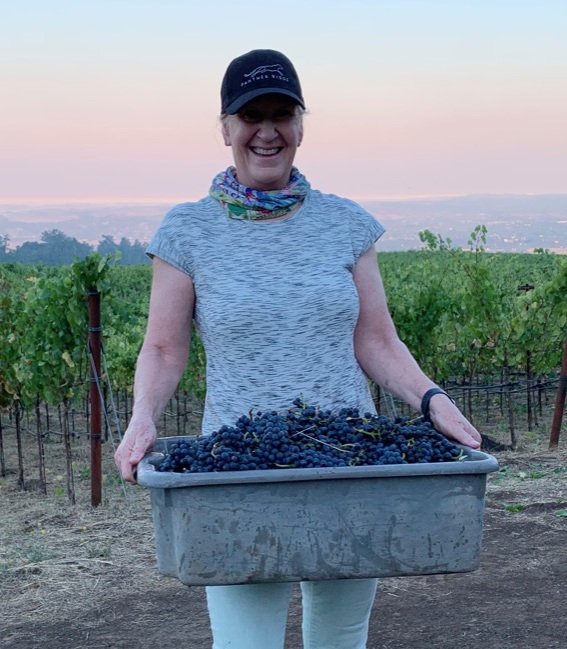
Suzanne Farver’s search for the perfect vineyard didn’t yield the results she was seeking; but once she found the perfect home with ten acres on a ridge of hay and thistle halfway up Sonoma Mountain, the path forward was settled. She would develop the vineyard herself. It required moving tons of boulders and a battle with thistles, but now her vineyard is producing two clones of Pinot Noir. Finding a buyer for her grapes was tough, so she decided to make her own wine, with the help of a fellow Sonoma County winemaker. Read Suzanne’s story on launching Panther Ridge and find out what she did with all those rocks.
Tell us about Panther Ridge, where it is, why you planted a vineyard there and how it got its name?
When we moved to Sonoma County, we rented a house for a year so we could decide where we wanted to be. I was looking for a vineyard, and I searched from Sonoma to Occidental, but I just couldn’t find the right combination of house and vineyard, and when we found a fabulous contemporary styled home about halfway up Sonoma Mountain with room to plant a vineyard, the pathway was settled. The land included about ten acres on a ridge of hay and thistle, with outcroppings of rocks here and there. When I was interviewing people to help develop and farm the vineyard, one of them said, “Lady, I’ve seen lots of nice vineyards in the valley with great production, but this place has sex appeal!” I knew then I was on the right track.
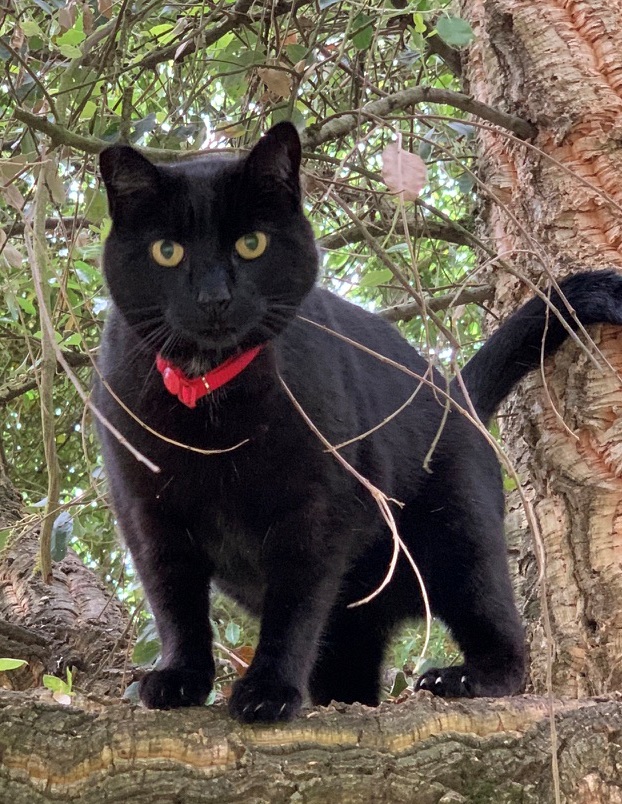
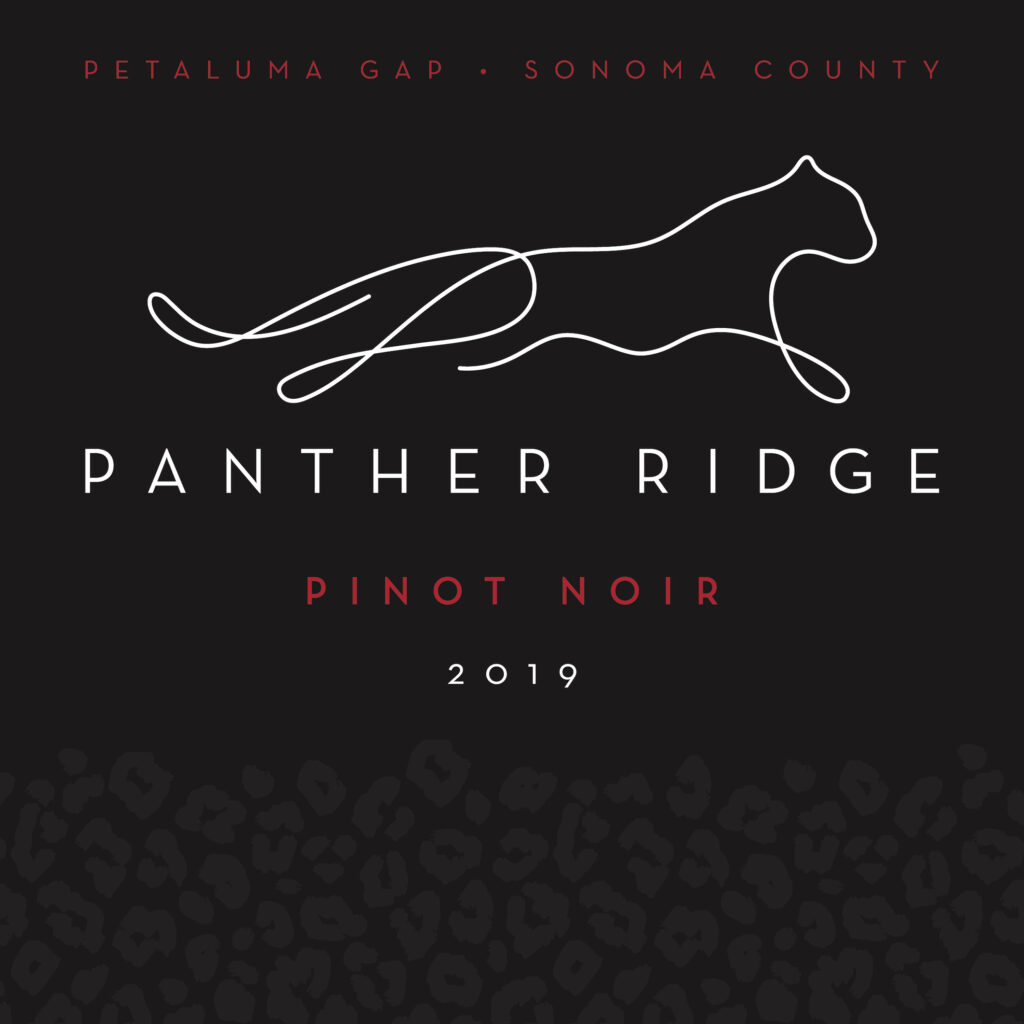
Regarding the name, we have a long history of wonderful black cats in our family, the first of which we named Mogli, after the little boy in Jungle Book. (Bagheera the panther was too scary for my young toddler girls.) When we moved here, another semi-feral black cat and his tuxedo brother adopted us – and a panther theme was settled. My winemaker had the idea of adding ridge to the name, and so here we are. A wonderful designer I knew from Colorado developed our logo and label. I love how the panther print design at the label’s bottom echoes the rocks on the ridge.
In order to plant the vineyard, you had to remove tons of rocks. How difficult was that and what happened to all the rocks you harvested?
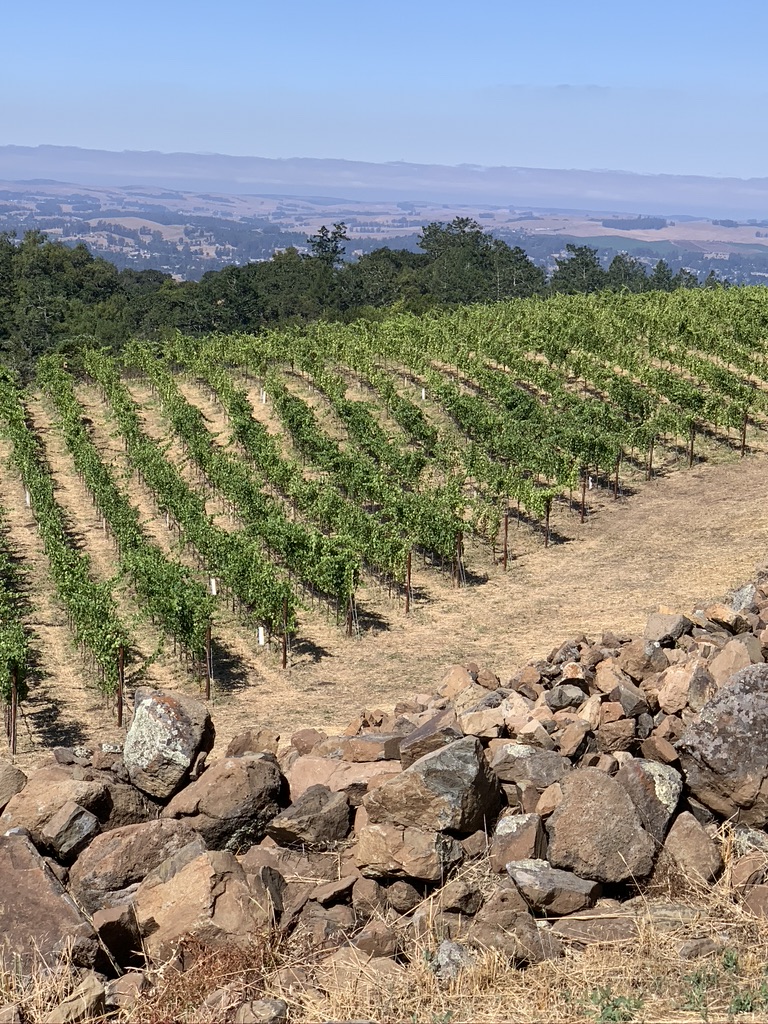
Oh my. A LOT OF ROCKS. We had no idea. When they ripped the soil, they weren’t able to rip as deeply as they wanted – there were just too many rocks. They spent weeks digging them up and moving them to a hillside that was too steep to plant. It became an enormous pile beyond our wildest imagination. The rule became – if you can pick up the rock with one hand, leave it there. If it takes two hands, then move it under the vine row. If it was bigger than you could pick up, it went into the front loader to the rock pile on the hill.
There was one little knoll that we called rock hill. Should we plant it or not? Are there just too many rocks?? We decided to plant it. We added a lot of compost during the planting of that block, and even so those vines have struggled to take root, but they are finally starting to bear fruit and will surely produce tasty wine for their efforts.
Pinot Noir is what is what you grow. Did you consider growing other varieties as well?
Tyler Kick of Redwood Empire Vineyard Management was key in helping to decide what to plant based upon our climate and soils. He recommended classic Pinot Noir varieties Calera with S04 root stock, and 115 with 1103P rootstock. We wanted root stocks that would be able to handle climate change and the future of drought in our area. When Tyler told me that Pinot was the varietal for our spot, I said (sarcastically smiling),” Oh darn! Do we have to??”
Panther Ridge is CCOF-certified organic and farmed biodynamically. Can you tell us why you pursued this path?
With my background in teaching corporate environmental and social responsibility, it was like “walking the talk” for me to farm organically. My main viticulturalist from REVM, Ricardo Costa, is from Portugal where his family farmed grapes organically, so he has been a great support. I came so close to caving to RoundUp because of so many thistles crowding the young vines, but in the end, I just couldn’t put poison on that virgin soil, and Ricardo supported me in finding other solutions.
REVM’s excellent record-keeping made it pretty easy to get certified organic. The biodynamic practice is my next step. I’m working with Pierre Millemann from Burgundy to get us there. He is an expert in the field, and his clients have included Domaine de la Romanée-Conti, and he also works with 00 wines in Willamette Valley. He advises us on both the biodynamic farming and the winemaking.
Jarold Mackling at Benziger Winery has been a wonderful help, providing advice and initial preparations. Now I stir and spray the biodynamic solutions myself, and we are also using the biodynamic calendars for reference in farming practices as well as winemaking decisions. I’ve always been fascinated by Rudolf Steiner and his work, so it’s exciting to be pursuing this path and see how it helps the vines to be more resilient with the coming pressures of climate change. Widely practiced by the best wineries in Europe, biodynamic support enriches the whole vineyard ecosystem and helps the vines live much longer, so you don’t have to replant as often.
Your educational background is in law and environmental sustainability. Which came first – your commitment to the land or your love of wine?
I think they just magically merged. My father collected French Burgundies, and I became fascinated with the subtleties of various wines as soon as it was legal for me to drink them. I owned two wine stores in my early 30s with my first husband, and I continued my investigation of wine after we parted ways, turning more and more to California wines as the wineries here became more sophisticated and the wines more complex. I love a Chardonnay without too much oak, and a Cabernet that is closer to 12 or 13% alcohol, but Pinot Noir has always been my favorite. Getting back to the land just feels right for me now, after growing up surrounded by farmland in Iowa. And having a law degree helps me negotiate contracts!
This year you will begin selling your first vintage of wine made from your own vineyard. Was the plan always to make and sell your wine, or was that a decision you made after harvesting your first crop?
Finding a buyer for my first crop was tough – we were a young vineyard with no reputation, even though we are a just a mile or so from Gap’s Crown Vineyard. I also realized that it is hard to break even on farming, especially organically, and so making the wine helps to get closer to a more positive bottom line. At the same time there is more risk, so I hope it is the right decision.
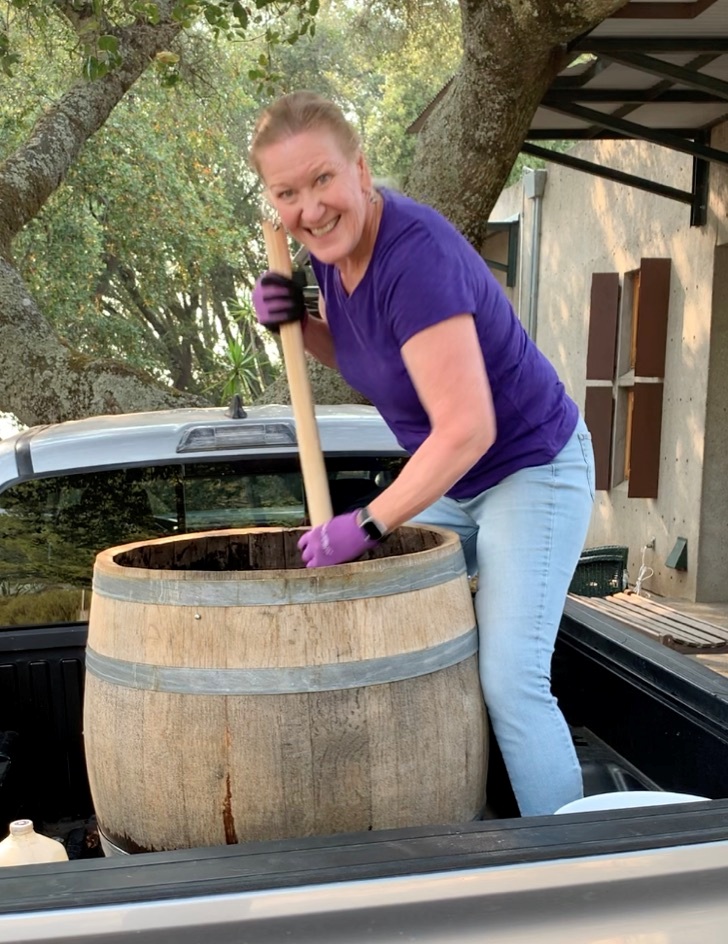
Who is making the wine and why did you choose this winemaker?
Adrian Manspeaker of Joseph Jewell Wines is my winemaker. I knew him because we both did Crossfit at the same gym (!) and I had heard he made great wine. I love the Pinots he makes from various boutique vineyards in Sonoma and Humboldt Counties – they are the nuanced, sophisticated wines I aspired to make. I reached out to him to see if he would be interested in buying grapes or making wine for me. He said he wasn’t in the market for grapes, but he would consider making wine for me. When he came up to see the vineyard, he said, “Uh oh, I didn’t think I wanted to expand my vineyard suppliers, but it looks like I may need to change my mind.” So, Adrian made the first vintage for me, in consultation with Pierre, and now he is also making his own wine from my grapes starting with the 2020 vintage. I now have other wineries interested in my grapes, so we are off and running.
Do you plan to sell your wines DTC? Will there be a tasting room?
Hmmm. One step at a time. I would love to have a tasting room and an excuse to adorn it with local art. We will see how this goes. For now, Adrian at Joseph Jewell Wines has been kind enough to take me under his wing, and perhaps I will get my own licenses to sell DTC in the next year or so.
You started your career at the Aspen Art Museum helping them raise money, get out of debt and develop the management team. Do you miss the art world? Are there lessons learned from that experience that apply to your new winemaking venture?
Oh wow. Yes, I do miss the art world. I still serve on the board of the Denver Art Museum, but I miss direct contact with artists – they are such interesting people beyond their own creativity. I guess what I learned from that experience is to be true to your values and your integrity, and seek the most excellent product, be it a curated show or a bottle of wine. Follow your heart and the challenges will fall into place. I always aspire to that, and it makes every day an adventure, from designing a label to catching gophers in the vineyard.
You went on to become an instructor at Harvard teaching classes on sustainability management, and also leading the board at Presidio Graduate School. Is Panther Ridge a showplace for the principles that you taught in your classes?
Absolutely. Part of what we are teaching in corporate sustainability is that being responsible to the environment and to your employees can be more profitable in the long run. You create a product that consumers feel good about purchasing, and a workplace where people want to be and will go the extra mile. I don’t have any direct employees at this point, but I try to create a positive experience with every vendor and worker in the vineyard – such as helping carry bins of grapes up the hill at harvest time and supporting the crew every way I can.
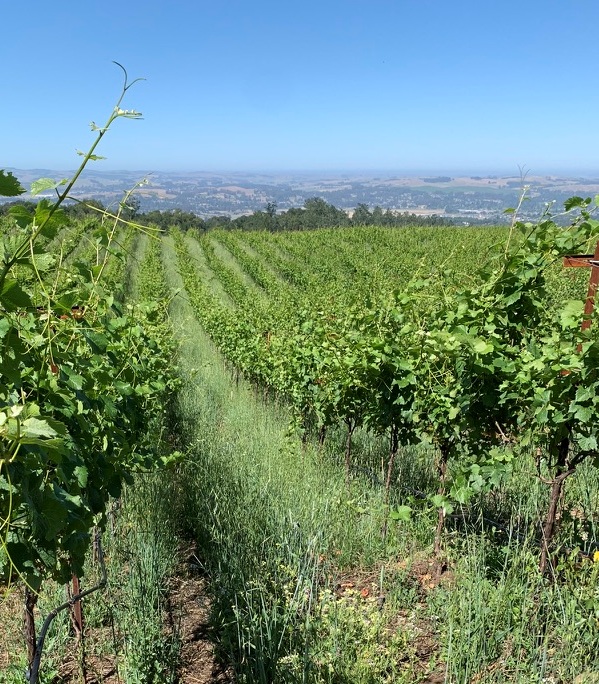
You’ve spent time in Iowa, Aspen, Cambridge and now Sonoma County. Is Sonoma County your forever home?
I grew up in a small town in Iowa, surrounded by family farms. That was when farmers lived on their farms and had a variety of crops and family gardens. There were pheasants in the woods, and wildlife everywhere. By the time I went away to school the farms were becoming large commercial operations, with acres and acres of “Roundup Ready” monocrops of corn and soybeans, and with commercial hog operations and cattle raised in feed lots. The wildlife was diminished considerably, and now it is even worse. I was saddened to see the pollution from commercial fertilizers.
My husband, Clint Van Zee, was a high school friend – we reunited almost 20 years ago. He was an attorney in Iowa during the 80s and 90s and spent a lot of his time connecting farmers to city water systems because their wells had gone bad from nitrate pollution. This was part of my interest in studying environmental sustainability, and eventually to become an organic farmer myself.
I moved to Colorado after my college graduation and lived in Aspen for 23 years. The beauty of the mountains was intimidating to me at first – so grandiose those mountain peaks. But I got used to it and loved the hiking and skiing. Clint didn’t ski, however, and we eventually decided to move to Sonoma County so I could pursue my lifelong interest in wine more directly, and he could be free from ice and snow. I love the combination of mountains and orderly rows of grapes – it is like a combination of Iowa and Colorado for me. I do think this will be our forever home.
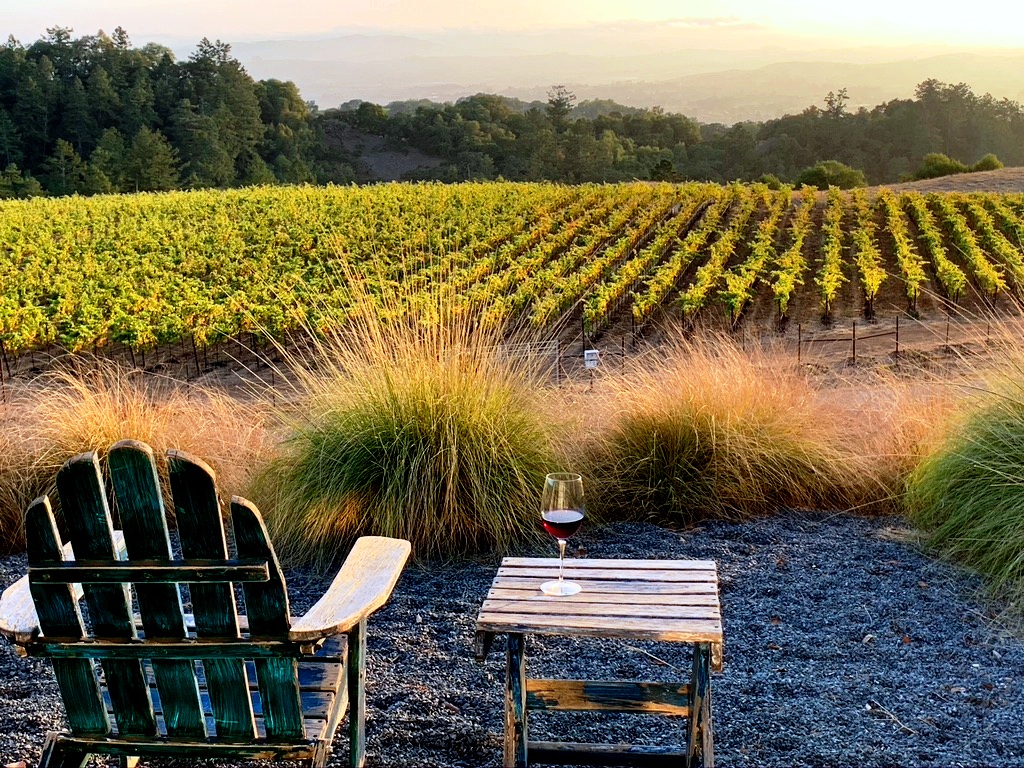
The Petaluma Gap is celebrated as a cool-climate growing region. Based on your writings about climate change, and looking through your crystal ball, what do you think lies ahead for the AVA? Will it remain a cool-climate region?
That is a tough question. The long-term prognosis for California is to be very dry indeed. The Petaluma Gap will most likely continue to be relatively cooler, but relative to what? How long will our water supply last? Will we need to change to the hotter climate grapes over time? I hope the transition will be gradual, but after what we have seen in the past few years, I fear that there will be extremes that will be stressful for us all.
If you had to give one piece of advice to growers in the Gap regarding climate change, what would you urge them to do?
Seek resilient practices. Wean your grapes away from water as best you can, to encourage deep roots. Stay away from commercial fertilizers and pesticides that will only weaken the vines in the long run and will develop short-term dependency. Encourage diverse wildlife – plant insectary blends and native plants around your vineyard, and put up bird houses and insect houses. Listen and watch and learn, and follow your passions.
